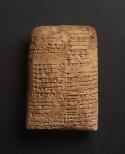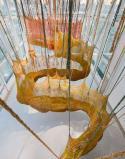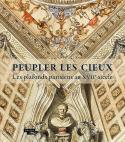Art Of The Day Weekly
#345 - from 8 May 2014 to 14 May 2014
IN THE AIR
Raysse, French style Pop Art
PARIS - He is known for his flashy colors, his neon lights, his installations inspired by consumer products (his Arbre (Tree) made with plastic bottles, his Etalage(Display) with brooms, detergent, laundry pins) and popular sources of leisure. During the famous Dylaby exhibit at the Stedelijk in Amsterdam in 1962, we saw a Raysse Beach,on which Rauschenberg and Spoerri "shook it all about" to the sound of the twist! Martial Raysse is the mos expensive French artist in the world, with Soulages, and he is now enjoying a retrospective of his life's work, a few years after his elder. Born in 1936, he is one of the last survivors of the group of New Realists, federated by critic Pierre Restany around César, Arman and Yves Klein, among others. The exhibition, with some 200 works, should allow us to better understand the personality of Raysse in the Pop movement, but also the rest: the artist, who is still active, has evolved and we wil see some of his most recent works, of which some are shown for the first time.
• Martial Raysse 1960-2014 at the musée national d’Art moderne, from 14 May to 22 September 2014.
EXHIBITIONS

Mary Cassatt, Little Girl in a Blue Armchair, 1878, oil on canvas, National Gallery of Art, Collection of Mr. and Mrs. Paul Mellon
The Degas-Cassatt connection
WASHINGTON - He was French (1834-1917), she was American, ten years younger (1844-1926). They wer both sacred monsters: the encounter between Edgar Degas and Mary Cassatt, orchestrated at the National Gallery, is not a thing of the imagination. It was fundamental in many ways as this exhibit, entirely dedicated to the subject, shows. "I would often go flaten my nose against that window to absorb his art as much as I could. It changed my life", Mary Cassatt wrote to describe her encounter with Degas' pastels in a shop window in Paris. The French painter introduced her to the circle of the Impressionists. In the other sense, Mary Cassatt impressed him deeply by her sense of experimentation. When he died he owned some one hundred works of hers. She had acquired a great renown in the USA with her frescoe of the Modern woman, presented at the Universal Exhibition in Chicago in 1893, and played a fundamental role to initiate the collectors to the audacious adventures of the Impressionists. The Modern woman has unfortunately disappeared and therefore is not in this exhibit. But, the nearly 70 other works shown explore efficiently the relationship knit between the two artists.
• Degas-Cassatt at the National Gallery, from 11 May to 5 October 2014.
Become a Wurm sculpture
FRANCFORT – By following the instructions of controversial Erwin Wurm, the visitors themselves have the possibility of becoming a piece of the museum. Half-way between Dadaism and conceptual art, the Austrian visual artists invites us be more critical in looking at the definition of work of art.
• Erwin Wurm, One Minute Sculptures at the Städel Museum, from 7 May to 13 July 2014.
The Clark years
NEW YORK – A one-of-a-kind personality on the Brazilian art scene in the years following World War II, Lygia Clark (1920-1988) is the object of an ambitious retrospective, with nearly 300 works of art. She is the founder of the neo-concrete movement, ans she considered art as much a social or therapeutic experience as an aesthetic one.
• Lygia Clark, The Abandonment of Art at the MoMA, from 10 May to 24 August 2014.
Charles V in Tunis
VIENNA – Emperor Charles V had taken with him to Tunisia his painter Jan Cornelisz Vermeyen to illustrate his glorious conquest of Tunis in 1535. While most of the tapestries are in Spain (Alcazar in Seville and Palacio de Oriente in Madrid), ten of the twelve twelve cartons, long considered works of art in their own right are kept at the Kunsthistorisches Museum. They present a surprising war report before they were in fashion.
• Emperor Charles V captures Tunis at the Kunsthistorisches Museum, from 7 May 2014 to 31 March 2015.
AUCTIONS

Lot 8: tablet of Drehem, IIIrd dynasty of Ur. Engraved cuneiform clay tablet, 10 x 6.9 cm. Origin: Ancient collection Allotte de la Fuÿe (1844-1939). Estimate €1 000-1500.
A selection of Oriental Antiquity
PARIS - This sale is brilliantly placed in the wake of the presentation of the Louvre Abu Dhabi. It is a complete panorama of all the arts of the Near East, made up of four major private collections. While the Xavier Guerrand-Hermès and Maurice Bouvier funds are known for the encyclopaedic knowledge they represent, the other two amaze us witht heir specificities. The Dufourmentel collection, built by a famous surgeon, sums up 20 centuries of the history of glass. More surprising still is the collection of colonel Allote de la Fuÿe who died in 1939 at the age of 94. It includes Sumerian tablets and other clay seals from the ancient administrative city of Drehem, built four thousand years ago. Contracts, inventories and other offerings resisted beautifuly against time and its trials. They will be useful to historians of the Ancient times, and some may discover a new destiny as mysterious objects, with a fascinating esoterismt.
• Arts d’Orient et de l’Islam at Artcurial on 12 May 2014.
ARTIST OF THE WEEK

Ernesto Neto, Life Is A Body We Are Part of, 2012. Crochet and polypropylene balls, 780 x 786 x 1.486 cm Collection of the artist.Installation view at Espace Louis Vuitton Tokyo. Photo: ©Louis Vuitton / Jérémie Souteyrat, work with the support of Espace Louis Vuitton Tokyo © Ernesto Neto, Guggenheim Bilbao, 2014
See, touch and feel with Ernesto Neto
We all remember his Leviathan Thot presented at the Panthéon in Paris during the Festival d’Automne de Paris in 2006: huge bags suspended from the ceiling, with round shapes - purses, tubes and pockets - spoke of an obvious biomorphism, sometimes with a sexual connotation. Brazilian artist Ernesto Neto was born in 1964 andhe is a direct heir of his compatriots, pioneer artists Lygia Clark and Hélio Oiticica, who believed that art had to be a sensorial and corporal experience. For over twenty years he has created installations, based in synthetic textiles which we can cross, on which we can bounce or we can even smell. At the Guggenheim in Bilbao, Gehry's great volumes were of course efficiently filled during his most recent retrospective, the air is full of spicy scents and one has the privilege of entering the Nef Utérus Chapelle, where the artist celebrated his mariage in 2001.
• Ernesto Neto, The Body That Carries Me is presented until 18 May 2014 at the Guggenheim Museum de Bilbao.f
OPENINGS OF THE WEEK
BOOKS
Ceilings from the Great Century
The French style ceiling has a flat background, based on joists, often decorated with a stencil. The Italian style ceiling is volted, covered with frescoes and stucco. In the middle of the XVIIth century, Parisian palaces turned away from the former and chose the latter. Unfortunately it is not easy to become familiar with these major civilian decorations, done by "stars" such as Le Brun and Mignard or by long forgotten artists such as Nicolas Loir and Jean Cotelle. Indeed many have disappeared and tose which have survived are generally hard to access – aside from the rooms in the Louvre and other National palaces or the recreation of La Rivière at the Carnavalet museum. It is now with peparatory drawings, collections of motifs or previously canvases that we can best imagine the variety and the magnificence of these ceilings. The exercice requires a certain capacity of abstraction and after reading this catalogue one should complete it ideally with the visit of the exhibition at the musée du Louvre, until 19 May. The private homes of La Vrillière (today the Banque de France), Brûlart, de Bullion, de Hirsch or of the Petit Vendôme… As non-specilists we -and others- would have appreciated a map of Paris with the location of the main sites and possibly the opening hours tthe public, if they can be visited.
• Peupler les cieux, directed by Bénédicte Gady, Louvre éditions/Le Passage, 2014, 320 p., €37.





